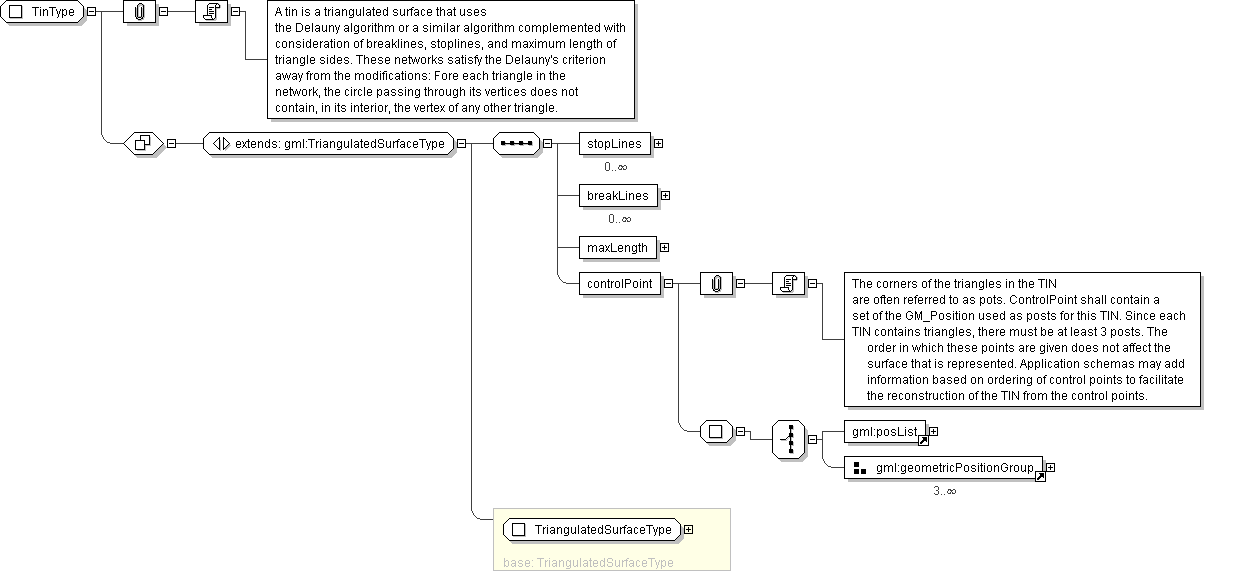
| Super-types: | gml:AbstractSurfaceType < SurfaceType (by extension) < TriangulatedSurfaceType (by restriction) < TinType (by extension) |
|---|---|
| Sub-types: | None |
| Name | TinType |
|---|---|
| Abstract | no |
| Documentation | A tin is a triangulated surface that uses the Delauny algorithm or a similar algorithm complemented with consideration of breaklines, stoplines, and maximum length of triangle sides. These networks satisfy the Delauny's criterion away from the modifications: Fore each triangle in the network, the circle passing through its vertices does not contain, in its interior, the vertex of any other triangle. |
'This attribute is included for backward compatibility with GML 2 and is deprecated with GML 3. This identifer is superceded by \"gml:id\" inherited from AbstractGMLType. The attribute \"gid\" should not be used anymore and may be deleted in future versions of GML without further notice.'
"'In general this reference points to a CRS instance of gml:CoordinateReferenceSystemType (see coordinateReferenceSystems.xsd). For well known references it is not required that the CRS description exists at the location the URI points to. If no srsName attribute is given, the CRS must be specified as part of the larger context this geometry element is part of, e.g. a geometric element like point, curve, etc. It is expected that this attribute will be specified at the direct position level only in rare cases.'
"'The \"srsDimension\" is the length of coordinate sequence (the number of entries in the list). This dimension is specified by the coordinate reference system. When the srsName attribute is omitted, this attribute shall be omitted.'
"'Ordered list of labels for all the axes of this CRS. The gml:axisAbbrev value should be used for these axis labels, after spaces and forbiddden characters are removed. When the srsName attribute is included, this attribute is optional. When the srsName attribute is omitted, this attribute shall also be omitted.'
"'Ordered list of unit of measure (uom) labels for all the axes of this CRS. The value of the string in the gml:catalogSymbol should be used for this uom labels, after spaces and forbiddden characters are removed. When the axisLabels attribute is included, this attribute shall also be included. When the axisLabels attribute is omitted, this attribute shall also be omitted.'
">'Multiple names may be provided. These will often be distinguished by being assigned by different authorities, as indicated by the value of the codeSpace attribute. In an instance document there will usually only be one name per authority.'
'This property encapsulates the patches of the triangulated surface.'
'Stoplines are lines where the local continuity or regularity of the surface is questionable. In the area of these pathologies, triangles intersecting a stopline shall be removed from the tin surface, leaving holes in the surface. If coincidence occurs on surface boundary triangles, the result shall be a change of the surface boundary. Stoplines contains all these pathological segments as a set of line strings.'
'Breaklines are lines of a critical nature to the shape of the surface, representing local ridges, or depressions (such as drainage lines) in the surface. As such their constituent segments must be included in the tin eve if doing so violates the Delauny criterion. Break lines contains these critical segments as a set of line strings.'
'Areas of the surface where data is not sufficiently dense to assure reasonable calculation shall be removed by adding a retention criterion for triangles based on the length of their sides. For many triangle sides exceeding maximum length, the adjacent triangles to that triangle side shall be removed from the surface.'
'The corners of the triangles in the TIN are often referred to as pots. ControlPoint shall contain a set of the GM_Position used as posts for this TIN. Since each TIN contains triangles, there must be at least 3 posts. The order in which these points are given does not affect the surface that is represented. Application schemas may add information based on ordering of control points to facilitate the reconstruction of the TIN from the control points.'
